G reyhoundThe

Gardens at Charterhouse: Gardening delights waiting to be explored
Sir Anthony Caro: One of Britain’s greatest sculptors
School News: Sports, music and capital projects
The Future of Design: Head of Design Engineering


















Gardens at Charterhouse: Gardening delights waiting to be explored
Sir Anthony Caro: One of Britain’s greatest sculptors
School News: Sports, music and capital projects
The Future of Design: Head of Design Engineering
















by Dr Alex Peterken, Head
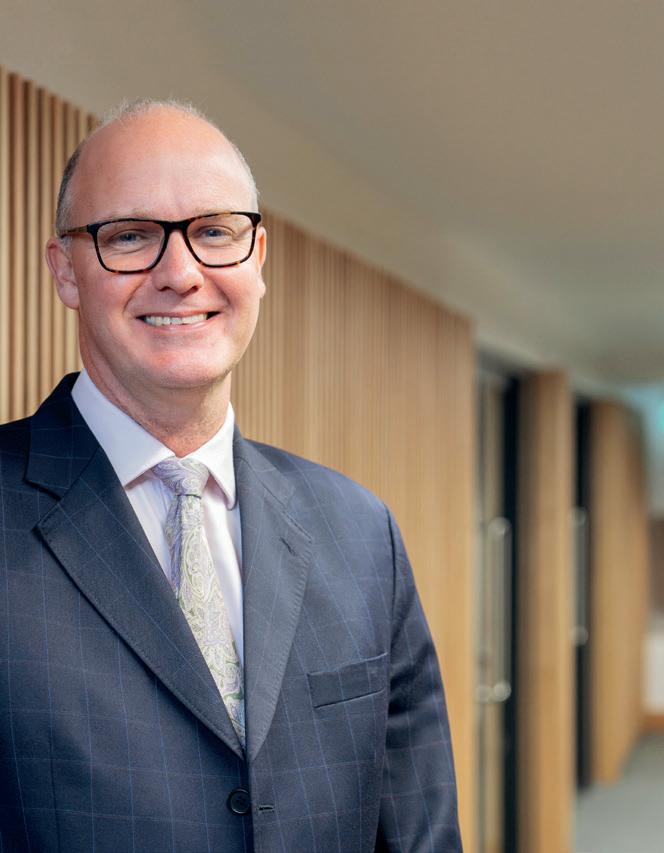
Whilst AI and robots will likely continue to replace manual, repetitive tasks at the dawn of this fourth industrial revolution, people will still be critical to activity that relies on distinctly human skills: skills that technology is unable yet to reproduce.
The most successful individuals within the workplace of the future will be those who can develop and maintain a set of flexible and transferable skills which inform how to think, how to work, and how to relate to those around us.
To support this, the world of education must continue to evolve.
The future career path for our current generation of Carthusians is no longer as linear as it once was. Gone are the days of lifelong commitment to a single profession. Instead, we witness a trend towards career fluidity, where individuals are likely to transition between roles, industries, and even career paths multiple times throughout their professional lives. In such a landscape, the ability to adapt becomes paramount.
Alongside an exceptional academic education, our young people will need to demonstrate flexibility, self-reflection and the ability to continually learn, if they are to thrive professionally and personally. To this end, it is vital that we equip them with a strong foundation and understanding of the transferable skills, professional knowledge, experiences and mindset that will be so beneficial throughout their later life.
In a world where automation and artificial intelligence are reshaping the employment landscape at tremendous pace, such skills and knowledge can offer a sanctuary of relevance. While machines excel at executing repetitive tasks, they pale in comparison to the nuanced capabilities of human intellect. Creativity, emotional intelligence, and adaptability are quintessentially human attributes that underpin innovation and drive progress. Therefore nurturing and continually evaluating these skills throughout one’s education, becomes not only advantageous but imperative for our pupils’ future success.
Moreover, the globalised nature of modern business demands a workforce that is not only proficient in their craft but also culturally astute and capable of collaborating across borders. As our Carthusians prepare to traverse the international stage of professional life, their skills and knowledge will serve as invaluable assets.
Charterhouse’s answer to this professional revolution is our FutureU programme, which aims to make our pupils amongst the most futureready young people in the world. This pioneering new curriculum is now central to the whole Charterhouse experience. The development of transferable skills takes place across every facet of school-life – indeed, schools like Charterhouse have always shaped such abilities, often via the osmosis of traditional academic work and the simple act of being at such an institution. Today, we aim to be much more structured and explicit in our approach, laying strong foundations by ensuring that every pupil understands the concept of transferable skills, the need to continually evaluate their personal strengths and weaknesses, and therefore how to effectively develop their skills, where needed.
Understanding the world of work, and the multitude of career options available has never been more
1. The Charterhouse 10 transferable skills
2. Life Hacks: increasing professional and personal effectiveness
3. An Entrepreneurial Mindset
4. Understanding the World of Work
5. Personal Brand Development
important. FutureU helps to illuminate the breadth of career opportunities available to our Carthusians by harnessing the power of our community of 10,000 alumni and parents. Guest lectures, seminars, workshops, 1:1 advice and networking opportunities bring pupils face-to-face with industry professionals, successful alumni, and renowned experts on a regular basis.
These connections offer invaluable insights into career opportunities. From guest speakers sharing their personal journey to networking evenings with our alumni and parents, pupils will gain a deeper understanding of their prospective career paths, supporting them to make informed decisions about their future.
An entrepreneurial mindset has been in the Charterhouse DNA throughout the generations. Such a mindset is about much more than having the drive to begin your own business – we see it as a way of thinking that fosters innovation, resilience, and creative problem-solving. Skills that are valuable to all.
The Charterhouse Entrepreneurship Diploma (CED) is a key component of our FutureU programme in the Sixth-Form. We are the first school in the world to offer a professional diploma accredited by the Institute of Entrepreneurship and Enterprise (IOEE), providing our pupils with the opportunity to gain a level 3 professional qualification in Applied Entrepreneurship, alongside their Sixth-Form studies.
To compliment this, a series of lifehack classes delve into life-skills that contribute to overall success and fulfilment. Workshops on themes such as time management, networking strategies, email management, managing stress, and financial literacy (professional and personal) are among the many life hacks that we offer.
Equipped with these practical skills, pupils will be ready to navigate the challenges of adulthood and make well-informed decisions for their personal and professional growth.
As educators, it is our duty to prepare our students not only for the challenges of today but also for the opportunities of tomorrow. By focusing on our innovative FutureU programme, alongside continued academic excellence, we empower our pupils to navigate the ever-changing currents of the careers market with confidence and competence.
I want to see Charterhouse at the vanguard of this evolution. A Charterhouse education should be the by-word for what it means to cultivate a generation of agile, adaptable, and resilient individuals who are not merely spectators but active architects of their professional destinies.
For each of our pupils, their Charterhouse education and our FutureU programme is the first important step on this life-long journey.


It is exciting to see the School’s new Art and Design extension nearing completion, which will provide additional gallery and creative spaces to nurture the next generation of young Carthusian artists, and what better example could our young artists have than the life and work of former Gownboy, Sir Anthony Alfred Caro (G1942), one of Britain’s greatest modern sculptors?
Anthony Caro was born in 1924, the youngest of three children. He followed his older brother, Peter, to Charterhouse, joining Gownboys in OQ1937. He was not an exceptionally academic pupil, nor a sportsman –his best subject at Charterhouse was mathematics, but he also enjoyed spending time in Studio and, aged 15, discovered that he had a particular talent for modelling clay. Caro’s Housemaster, Mr Ivor Gibson, encouraged his interest in sculpture and introduced him to the eminent sculptor, Sir Charles Wheeler, who offered Caro the opportunity to help him in his studio during the school holidays.
Anthony’s father was a successful financier and hoped that he would join the family stockbroker firm – art could be a hobby, but was not considered to be a proper career. As finance did not interest him, Anthony’s father suggested architecture or engineering

as professions that combined both mathematics and drawing. He therefore dutifully went up to Christ’s College, Cambridge, in 1942 and took a degree in engineering, but spent the holidays creating sculptures at Farnham School of Art.
In 1944 Anthony was conscripted into the Royal Navy (Fleet Air Arm), serving as an air engineering officer in Plymouth, repairing aircraft. It was here that he first considered sculpting in metal, using his newly acquired practical metalwork skills to create abstract metal sculptures. Anthony’s family finally agreed that he should attend art school. In 1946 he went to Regent Street Polytechnic to study sculpture, and then to the Royal Academy the following year: he won the Landseer Prize in 1948 and 1949, and three medals for composition, clay figure modelling and carving. It was here that he met his future wife, Sheila
“You have got to take risks and surprise yourself.”1
Girling, when he accidentally used her drawing board during a class. They married in 1949 and began what they described as a “64-year conversation about art”, in which they informed each other’s work. In particular, Sheila’s chromatically brilliant paintings influenced Caro’s choice of colours in his sculptures. They had two sons, born in 1951 and 1958.
In 1951 Caro took the bold step of visiting Henry Moore’s home, unannounced, and asking to work with him. Henry Moore was somewhat taken aback, but asked him to come back in six months, which he did, starting as a part-time assistant. Caro relished the opportunity to help Moore build a bronze foundry in his garden and to learn from his creative process.
Caro is remembered, not only as a great sculptor, but as an inspirational and generous teacher. In 1953 he was
invited to teach part-time at St Martin’s School of Art and he continued in this role for nearly thirty years, creating its Department of Sculpture, whilst at the same time developing and exhibiting his own work. He encouraged his students to question all their assumptions about sculpture and to take risks, thereby having a profound influence on the development of British sculpture during this period.
A stimulating and enriching visit to the USA and Mexico in 1959 profoundly changed Caro’s sculpture. Following the advice of New York sculptor, Clement Greenberg, that “if you want to change your art, change your habits”, Caro started using industrial
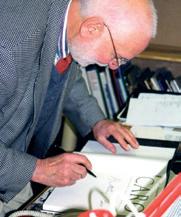
“ Making art is one’s life. There’s always the next masterpiece you’re going to make tomorrow. You may not – but there is always hope.”2

scrap metal as his material. He also took the revolutionary step of removing his sculptures from plinths and placing them directly on the ground so that they were not elevated from the viewer. His linear metal sculptures challenged orthodox ideas of modern sculpture; he used brightly coloured paints and gave his work titles simply chosen from the commercial labels on his paint cans, seemingly laughing at the intellectual art establishment. By 1969 Caro was recognised as the leading sculptor of his generation; his first major retrospective at the Hayward Gallery, London, received much acclaim and he was appointed CBE in the same year.

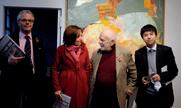
A
1 The Carthusian, 2001
2 Ibid
Never one to rest on his laurels, in the 1970s Caro moved away from colour and changed his material again, using large sheets of heavy duty rusted steel. A decade later, he changed again to collaborate with artists in other fields, creating sculpture from handmade paper and from ceramic.
He was knighted in 1987 and in later life his work became grander in scale, sometimes combining sculpture and architecture to create towers that could be climbed. Caro collaborated with architect Norman Foster to design the Millennium Bridge in London. His ‘Last Judgement Sculpture’, a 25-piece installation using stone, wood, steel, brass and concrete, was created in response to the suffering caused by conflicts in Bosnia and Rwanda. His visionary design for the ‘Chapel of Light’ at Saint-Jean-Baptiste Church of Bourbourg near Calais, completed in 2008, used wood, steel, iron, concrete and stone sculptures to bring new life to this war-damaged space. He continued working right up until his death in October 2013 – one of his final works was a large-scale sculpture that was exhibited at the Royal Academy’s 2013 summer exhibition.
On several occasions Caro welcomed young Carthusian artists to his studio, generously sharing his time and experience and even inviting them to try their hands at welding.
The Greyhound
From the Archives
Charterhouse is undoubtedly one of the most beautiful schools in the country. The Victorian gothic buildings soar majestically above the surrounding countryside, but they are also, quite literally, an organic part of the landscape, built from Bargate sandstone hewn from the surrounding hillside. The extensive School grounds offer a smorgasbord of gardening delights, just waiting to be explored.
When the School moved from London to Godalming in June 1872 the original 68-acre site was a blank canvas: the new buildings, barely finished, were surrounded by “a wild tangle of gorse, yellow broom and vipers bugloss”1 , which had to be cleared, flattened and turfed to create playing fields. Over the years the site has expanded considerably – 2024 is the centenary of the most significant addition, Northbrook Place (now called Fletcherites) and the Northbrook Estate (all the land to the west of J Ground and Under Green). Today our 250-acre School grounds comprise 55 acres of formal gardens and lawns, 80 acres of ancient woodlands with some wonderful views across the Wey valley, a 30-acre golf course, and extensive playing fields and all-weather pitches. The grounds are lovingly tended by a dedicated team of 15 staff, led by Grounds Manager, Liam McKendry.
We caught up with Head Gardener, James Greenshields, who has worked at Charterhouse since 2011.
“Charterhouse is a special environment to work in and I am very aware of the amazing history of the place. We try to strike a balance between modernising the site and keeping the strong historical context that the gardens have. On the old side of the campus we aim to keep a traditional cottage garden style (in keeping with Gertrude Jekyll), but we have a much freer rein around the new buildings – generally we have more modern shrub borders, but we can also be experimental. You will see some areas that are being re-wilded and we are mindful of the need to garden sustainably and choose plants that are drought-resistant and resilient to climate change.”
The garden surrounding Reception has been influenced by two famous British garden designers: Gertrude Jekyll and Russell Page (S1923).
Gertrude Jekyll (1843-1932) was a wellknown British horticulturalist and garden designer. She spent most of her life in
Surrey, but she created gardens across the UK, Europe and the USA, and her ideas have had a lasting influence on garden design. She collected plants for her garden at nearby Munstead Wood, selecting those that were hardy and could thrive in Godalming’s sandy Bargate soil.2
This area was originally a garden for the Headmaster, who lived in Saunderites, with a tennis court in the middle.
Gertrude Jekyll’s papers include two sketch plans of her proposed alterations to the “Headmaster’s Garden” dated 18983. Part of this garden was covered by the new Headmaster’s House (now Reception) in 1958, but the original pergola has survived, together with two long flower beds and a dry-stone wall along the boundary with Prince’s Avenue; the summer house was designed by Jekyll’s friend and collaborator, the architect Sir Edwin Lutyens.
Russell Page (1906-1985) was a worldfamous garden designer, whose book, The Education of a Gardener, is still

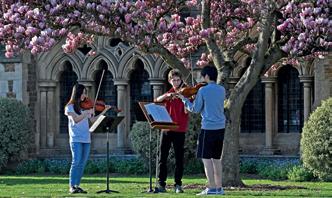

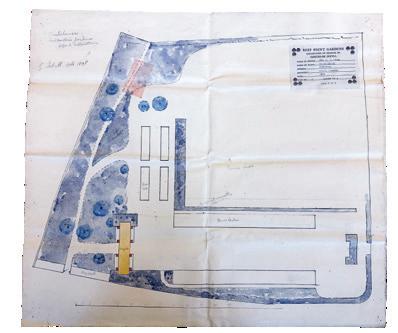


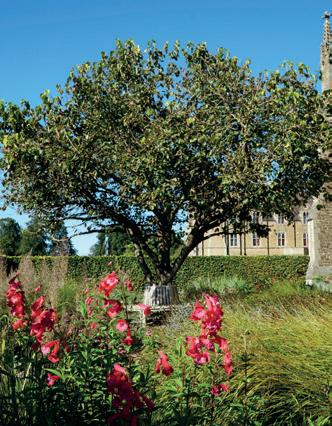

in print and is renowned amongst landscape architects4. Russell Page excelled as an artist during his three years in Saunderites and he had a passion for plants and especially rock gardens. He visited as many gardens as possible and was particularly inspired by Gertrude Jekyll’s ideas. From the age of 17 he was accepting garden design commissions and went on to study at the Slade School of Fine Art and in Paris.
Russell Page created gardens for many prestigious clients all over the world, but also found time to advise Charterhouse. In the 1930s he produced a comprehensive plan for Headmaster Sir Frank Fletcher and Lady Fletcher, some of which was implemented (but not his most radical suggestion for an amphitheatre opposite Founder’s Court!)5. He returned to Charterhouse again in the 1950s and designed a planting scheme to extend the garden around the new Headmaster’s House6
This little oasis between Engineer’s Cottage and the Hub was created in memory of General Alan Fleming Hartley (W1899), Commander-in-Chief of forces in India during World War Two. It has plants that will cope with the very difficult growing conditions under the pine trees.
Brooke Hall Garden
This enclosed south-facing garden next to Brooke Hall is for the use of staff and has late spring and summer flowering perennials and shrubs. The patio area has recently been extended and re-planted. A mature lime tree provides much-needed shade in summer. The armillary sundial on the lawn was given to Brooke Hall by Oliver Van Oss (Headmaster 1965-73) and a Pagoda Tree (also known as a Scholars’ Tree) was presented in 1996 by Clive Carter (D1960, BH65-66, Acting Headmaster 95-96).
1 A H Tod, History of Charterhouse (publ. G Bell & Sons, 1900)
2 www.nationaltrust.org.uk/visit/surrey/munstead-wood-project-updates
3 UC Berkeley, Environmental Design Archives, Gertrude Jekyll Collection 1955-1
4 The Education of a Gardener, Montague Russell Page (1962) ISBN: 9781860460425
5 Charterhouse Archive 47/94; plans 165/233
6 Charterhouse Archive 64/07 plan and planting scheme c1956-57
Memorial Chapel
The planting around Memorial Chapel is determined by two contrasting environments: on the north-facing side is a selection of shade-loving shrubs and perennials, whilst sun-loving, drought-resistant plants thrive on the south-facing side.
Scholars’ Court
This peaceful courtyard garden in the heart of the School recreates the monastic style of Charterhouse in London. In the centre of the cloisters is an ancient Venetian stone well-head, presented to Charterhouse as a memorial to England footballer, James Prinsep (R/W1878). The old cherry tree in Scholars’ Court flowers very early in the year, heralding the approaching springtime.
South African Cloister
The curved border is planted with seasonal bedding – Forget-Me-Nots in the spring and Charterhouse-pink Pelargoniums in the summer. The splendid Magnolia, featured in many Charterhouse photographs, flowers from mid to late spring.
At the west end of Old Music School, tucked away behind tall copper beech hedges and rusted metal screens, is the recently reconfigured ‘wellbeing’ garden, which has been designed to engage all the senses and promote good mental health: a water feature provides gentle background sound, tall grasses sway in the slightest of breezes, climbing roses add both colour and scent. A sundial on the north side commemorates W Stuart Macpherson (W1989) and in the centre is a mature mulberry tree. Facing south and east, this garden is a secluded sun-trap that offers the perfect opportunity to relax and enjoy the soothing sensory environment.
This clearing on the south-facing woodland slope beyond Green and Big Ground was originally an orchard and vegetable garden to supply the Gownboys kitchen. It is currently being cleared by our Duke of Edinburgh Award pupils so that the area can be used for various practical teaching projects, such as growing vegetables, re-planting the orchard and drystone walling.
The sunken courtyard between Lockites, Weekites and the CDR is having a make-over! To soften the concrete in this area, Head Gardener James Greenshields is using a tropical planting style, incorporating large-leaf plants and a selection of hardy palms. Some of the paving slabs will be removed and climbing plants added to the walls to create a tropical oasis within a very built-up area of the School.
This pretty garden space between the Central Dining Room and Fletcherites was laid out in 2009 with the aid of a bequest to the Carthusian Society from Robin Beatson (W1944). A brick path winds enticingly through the garden to a circular stone seat in the middle. The planting offers interest and colour for every season: betula and cornus trunks surrounded by snowdrops and hellebores in winter, a profusion of spring bulbs and, in the summer, foxgloves and aliums. Behind the Beatson Garden is a half-timbered Dairy, designed by Sir Edwin Lutyens in 1895.
A profile of Claire Wang, Fifth, Sutton

An accomplished pianist, Claire Wang competes at an international level.
“I was inspired to learn the piano at just 4 years old after hearing my older brother play. None of my family are musical! My parents didn’t force me, I simply enjoyed playing. At the same time, I picked up the violin as my second instrument. When I was 7 years old, I took a Grade 8 exam in piano and Grade 7 on the violin. I stopped the violin when I was 13 years old because I wanted more time to concentrate on the piano.
I was 7 years old when I applied to my music school, the Yehudi Menuhin School in Stoke d’Abernon, Surrey for gifted young musicians. I performed my first ‘showcase’, ticket-selling concert, when I was 8 years old. At the concert I played a Beethoven Sonata. I barely remember the experience but I recall backstage that I had some older friends supporting me. The concert took place in the Menuhin Hall, a spectacular 300-seater concert hall, a purpose-built performing space at the school. I studied at the Yehudi Menuhin School for 6 years and most of my early concerts took place in the concert hall.”
Claire has had phenomenal success participating in competitions at an international level. She prepares herself with hours of practice.
“ Claire is an exceptional talent who makes a significant contribution to musical life at School. In addition to winning the piano prizes and external international competitions this year, she has also been a member of the Choy Piano Trio who were finalists in the prestigious Pro Corda National Chamber Music Competition.”
Mr David McKee Director of Music
“Right before a competition, I like to take a nap! I tend to play very long pieces in competitions so need to be well rested. Sleeping helps with my memory. I also like to eat something sweet about half an hour before my performance, such as a banana. Some people practise a lot before entering the stage but I like to read the score in silence and take in everything I’ve annotated on my sheet music. My teacher gave me that advice and I just do it! Combining these steps, I feel physically and mentally ready to perform. This is the final stage after weeks of practice in the run up to a competition.
All of my piano competitions have been memorable. I don’t have one standout competition. Competitions are the ideal opportunity to perform in different challenging, new environments. I learn from the jury as well as the other competitors often from different nationalities. Each time I compete I prepare myself better for the experience and get new ideas for my pieces from my teachers to perform better.
However, I do feel that music is something that shouldn’t be competed for. It is art and people can have different opinions. It’s not like maths, there’s no one right answer! Everyone has an individual interpretation. The competitions provide a platform to perform.
All of my competitions are international, I enjoy them because I meet and discover ideas from people from all around the world. I practise every day
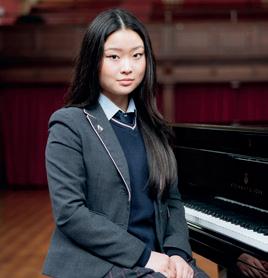
in Hall at 7am for an hour before Adsum (registration). It guarantees my practice no matter what I have on during the day. I have a piano at home obviously but I’m a day pupil and coming in to School helps me to focus without distractions. I increase the amount of practice in the run up to a competition but I strike a balance with my academic studies.
I’m studying for my GCSES and I’m excited for my A Levels which I’ve chosen to be Philosophy, Music and Maths. When I was in the Fourth Form, I studied TPE (Theology, Philosophy and Ethics) and it was this experience that inspired me to choose Philosophy for A Level.
I’m in Sutton House. Mrs Alice Evans, the Head of House and the teachers are very supportive and helpful. I leave School to go to London for piano lessons. Our House is quite musical. We won House Singing this year with a rendition of Cheap Thrills (Sia). That’s twice out of my three years in Sutton!
Claire’s competition successes
My advice to younger pupils who would like success in music is to practise every day and embrace the constructive feedback from friends or teachers. Piano is not just physical, it’s mental, you have to think. I would encourage them to listen to other people perform and to surround themselves with as much variety of music as possible. Finally, perform in as many concerts as possible because it isn’t easy!
In the Summer term I’ll be performing at Artifex, the School’s arts festival, now in its 10th year. On the Saturday evening, there will be a 10th Anniversary Outdoor Concert and I will play Rachmaninoff Piano Concerto No. 2. It is a privilege to play this half hour piece. Audience members are encouraged to bring a picnic and to enjoy a midsummer’s feast of music as Artifex comes to an extravagant close.
I hope to take part in more international competitions after a short break to focus on my GCSEs this summer!”
1st Prize at International Competition Val de Travers 2023 (Neuchâtel, Switzerland)
1st Prize at Amadeus Competition (Italy)
1st Prize at International Sicily Piano Competition (Italy)
1st Prize at Kings Peak International Music Competition
1st Prize at the V China-UK International Music Competition (Online/China/UK)
1st Premio Assoluto at Cola Femmina International Competition (Italy)
1st Prize at Orbetello International Piano Competition (Italy)
1st Prize “Primo Premio Assoluto” at the Euterpe 10th International Piano Competition (Italy)
1st Prize at Euregio International Piano Competition (Italy)
1st Prize at American Music Talent International Competition (Online/USA)
1st Prize at the V China-UK International Music Competition (Online)
2nd Prize at Chopin Avenue International Piano Competition (Poland)
2nd Prize at the Antonio Vivaldi International Piano Competition (Austria)
Best Interpretation of Chopin Prize at the International Anton Rubinstein Competition (Germany)

Isabelle Duncan (S92) – President
It’s hard to believe that I studied Theology at Durham University. To be honest, I was more attracted by the cricket pedigree and sport opportunities there. I’m lucky enough to be paid to watch and write about cricket and commentate for radio with some TV work thrown in. Highlights have been my interviews with cricketing royalty such as Mike Brearley and David Gower. As President of The Cricket Society Trust I am determined to raise funds for disadvantaged children, including an Afghan refugee girl cricketer, so that cricket can be a force for good in their lives. As a playing member of MCC, I have relished two spells on the Main Committee with the great and the good. I’m the author of ‘Skirting the Boundary – a History of Women’s Cricket’ and I’m keen to shift the remaining copies from my sitting room. In the close season, I can be found ski-touring, cycling, on a real tennis or padel court or floundering on an elephant polo pitch in Bangkok. In my role as President of the OC Executive Club I am keen to push for more OC female participation to reflect the blossoming coeducational existence of the School. I’m already feeling buoyant after our first Old Carthusian cricket match played against the Charterhouse girls on Carthusian Day.


Indy Bhattacharyya (G94) – Treasurer
Indy Bhattacharyya joins the Committee as Treasurer. After Charterhouse, Indy attended Oxford University and spent 23 years in investment banking before joining NetJets Europe as their Vice President.
After receiving a Music Scholarship to Charterhouse, I went on to study Music at Liverpool University, then Cambridge University for my postgraduate certificate in Education. I spent ten years working in television as a Celebrity Producer working on shows such as Strictly Come Dancing, I’m A Celebrity Get Me Out of Here and Hell’s Kitchen. I then moved to Dubai with my husband and played viola professionally in the UAE Philharmonic Orchestra as well as becoming Director of Music at Jebel Ali School. I am currently back in the UK with my family and have recently taken on the role of Director of Music at Cobham Free School.
I was delighted to be asked to become the Secretary for the OC Executive Club, as a current Charterhouse parent and as an OC. I have recently reignited the OC Music Society and hope to organise a concert soon.

Chris Kurkjian (W93) – OC Societies
I attended the University of Surrey and the University of North Carolina where I studied Business Studies. After university, I spent twenty years in banking with Merrill Lynch, Royal Bank of Canada and Banco Santander before joining Thomson Tyndall as an Independent Wealth Manager. Since joining Thomson Tyndall, I have become a Chartered Fellow of the Chartered Institute of Securities & Investments and I am the Head of the Charities Team, managing the investments of private families and charitable foundations.
I really enjoyed running the OC Tennis Society for 10 years and was invited by the President of the OC Executive Club, to help oversee the broader OC sporting societies – which has been great fun. I want to support the societies to encourage young OC participation and hold more meetings, thereby increasing our network size and our enjoyment together, post leaving School.

Ed Rees (L91) – OC
Having graduated from Durham University in 1996 with a BA in Education, I moved to London and joined Dulwich College where I spent 16 very happy years. In addition to teaching and tutoring within the boarding house, I completed two assignments for the Dulwich schools in China and qualified as an ISI inspector. After 11 years as Deputy Head of the Junior School, I moved to Hornsby House School where I have been Headmaster for 12 years. I am also a governor at Bedales.
I loved my time at Charterhouse and after I had left was fortunate to enjoy many years playing for the OC Football Club and Charterhouse Friars, making many lifelong friends. I was also fortunate to be a Charterhouse parent for two years with my daughter completing her Sixth Form years in Northbrook. Knowing how much I have benefited from being part of the Charterhouse family, it was hard to say no when asked to join the OC Executive Committee! I would like to help in any way that ensures current and future OCs enjoy the same experiences that I have. Furthermore, with Charterhouse going fully co-ed I believe that this is an exciting moment to develop opportunities for the girls and elevate their status within the OC community.
The OC City Association was delighted with the success of the champagne reception held at the offices of JM Finn last summer.
The event was attended by over 75 OCs from the business worlds of banking, hedge funds, investment management, private equity, trading, M&A, energy, technology, insurance, accountancy, and law. The attendees were made up of a wide variety of vintages, from recent leavers and university undergraduates, through to more senior managing directors and business heads. Many useful introductions and new connections were made between attendees during the event.
The main purpose of the OCCA is to organise business networking events where OCs connected with the City can meet and get to know each other. It is hoped that events will provide the opportunity for OCs to make new friends socially and potentially help each other out in the business world. The association also helps current Carthusians or younger OCs with first-hand guidance on further education and careers, as well as with work experience opportunities.
The OCCA are planning to hold another event soon.
If you would like to join the OCCA and be added to our mailing list, please do contact us at occity@hotmail.co.uk and join the OC City Association on LinkedIn (search OC City Association) or the OC City Association on Charterhouse Connect.
For further information on the OCCA Hong Kong branch, please contact Zak Allom, Hong Kong Chairman (W93) at zak.allom@betasmartz.com, copying in occity@hotmail.co.uk

Calling all musicians, singers and music lovers! Francesca Lett (née Knowles) (g92) is keen to reinstate the Old Carthusian Music Society and would love to hear from anyone keen to join. There will be opportunities for music making, socials, music appreciation and links with the current music department. We are hoping to also organise another OC Choral Day in the near future.
Please do let Francesca know if you are interested by dropping a quick message to OCMusicSociety@gmail.com or through OC Music on Charterhouse Connect.
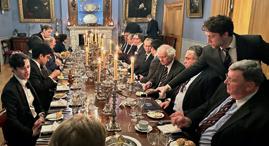
The Charterhouse Deo Dante Dedi Lodge is an active club with over 120 years history with 52 members ranging from our eldest at 93 and our youngest at 20 years old. Our members comprise of OCs, former members of Brooke Hall and Brothers of Sutton-in-Hospital. At our most recent meeting in March 2024, we welcomed two new members, both under 25, and we are growing our younger membership.
Our meetings and dinners are held four times a year. At our meetings/dinners, all attendees contribute to the charitable maul which is then applied to various charitable campaigns. At our March dinner, we raised funds for London Air Ambulance and Polycystic Kidney Disease Charity.
We are part of the Public Schools Lodges Council (in fact we are a founding member and the PSLC represents 38 Public School Lodges). We have close ties with certain other school lodges – notably, Eton, Harrow, Stowe and Winchester where we would host joint meetings and dinners (for example, with Eton last year and Stowe this January).
It should be noted that all dinners are open to all OCs and each year we also have a black tie dinner specifically targeting female guests. This would be at one of our future dinners later this year – details to be confirmed.
Please note that females are open to joining female freemasonry either at The Order of Women Freemasons (owf.org.uk) and HFAF (hfaf.org) – Freemasonry for Women. These Lodges mirror their male counterparts in both ceremonies and attire, and their members frequently collaborate on charitable endeavours within their communities. It should also be noted that one of our members, Simon Chen is the Deputy Chairman of the PSLC. PSLC are currently supporting HFAF in the creation of an “Old Public School” females lodge which would not be school-specific.
Please see photos of our recent dinner at Wax Chandlers Hall in the City of London in our Charterhouse Connect group. Simon Chen (P89) can be contacted about any enquiries at simonadamchen@gmail.com

The OCYC started our year in early February with a sumptuous dinner in the House of Commons hosted by Mark Garnier MP (P81) to honour the 2022 Arrow Trophy crew and members of the Club who supported the event. Charterhouse had come a very creditable 4th overall winning the Radley Shaker. The end of the month saw us at the Army and Navy Club hosted by Peter Munro (H62) for a tasty curry evening which included stirring readings and the singing of sea shanties!
The June Rally took place in Cowes. The weekend started with a race commemorating Commander Lord Edward Downes Law, 5th Baron Ellenborough, S1854. Mikado managed to pull away from the rest of the fleet early on and won a commanding victory. Following dinner in the Royal Yacht Squadron and a good night’s sleep, OCYC members were joined by current pupils and beaks in the now annual races in J70s. These are lively keel boats and great fun.
The J70 racing was preceded by the crews being treated to a grandstand view of some close racing by classic yachts in the Richard Mille Cup, a highlight being the Redjet ferry putting on a serious burst of speed to avoid being skewered by a three masted schooner on the start line. The racing was followed by a sumptuous cream tea back at The Royal Yacht Squadron.
July 1st saw the annual world famous Round the Island Race (RTIR), which circumnavigates the Isle of Wight. Conditions round the back of the island were very much on the wild side and saw some boats dismasted or capsized and many boats retire. Several OCYC boats reported sail and running rigging damage. There are two prizes awarded by the OCYC for this event. For the second year running, Xara, skippered by Jonathan Rolls (W64), won the Cecil Donne Trophy for top OCYC boat in class IRC. Eagle, skippered by Jim Miller (P85), again won the Beaumont Trophy, with an entirely OCYC crew. An intense and tiring day.
Our August Rally took place at Lymington, renamed Port Vernon for the weekend. In an OCYC first, six OCYC boats arrived at Port Vernon to take part in a hunt for the Rt. Hon. James Vernon’s Treasure, which had last been seen in 1857 and had remained hidden ever since. Hunters followed a set of clues and a very old treasure map to find the coordinates of where the treasure was hidden. After a day of fun and hilarity, with everyone entering into the spirit of the occasion, Stephen Carter (S71) duly found the treasure! A highly successful event.


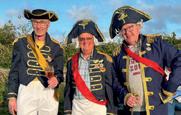
Early October saw the OCYC compete in the annual independent schools’ Arrow Trophy for alumni. The Charterhouse crew were supported enthusiastically on the water by David Aisher (S68), Jeffrey Matthews (g62) and Tim Miller (P83) on board classic motor yacht Cerveza. Charterhouse had an extremely good series of races, finishing a fantastic 2nd overall, our highest placing for 10 years and winning the Sherborne Salver.
Early November saw us gather together for Bessie’s Gallop – Walter’s Whomp. Walter Manny’s most notable legacy was his part in the foundation of the London Charterhouse, a process which began during the terrible Black Death winter of 1348-9. This race is held in Good Queen Bess’ honour, close to the anniversary of her accession as Queen of England, her gallop to the London Charterhouse and her forming there of her Privy Council prior to riding into the City of London. Boats converged on Cowes in the stormy conditions which have been a feature of previous years.

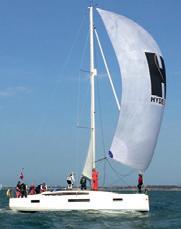
Thalia reported a gust of 52kts, which caused her working jib halyard to let go. Nevertheless, everyone made it in time for dinner at the Royal London Yacht Club.
The next morning Thalia, Balerno, Magewind and Eagle battled for the Rum Barrel prize. Conditions had moderated slightly but were still pretty unpleasant. Balerno and Thalia retired, leaving Magewind and Eagle to fight it out. Magewind caught Eagle on the final upwind leg but Eagle then seemed to find an extra gear and sailed side by side with Magewind for much of the rest of the race. Line honours went to Magewind, with Eagle just pipping her on handicap. The race was a fitting if stormy end to another busy and successful year.
2024 sees another full list of fixtures for the OCYC. To join in or find out more, contact Tim Miller, Hon. Secretary on ocyc.hon.sec@gmail.com or through the OCYC Charterhouse Connect group.

Women’s football has truly been on the rise in the UK, at Super League level, National level (following the Lionesses’ win at the 2022 Euros) and now, at Charterhouse. With increasing popularity, the 1st XI has seen more and more success, with the School becoming fully co-ed, the U15 girls’ football team has also had an excellent start. Now seems a good time to introduce an OC Women’s Football Club in order to continue this culture of women in football. We are anticipating our debut match against the 1st XI in 2024. Get involved with the club by emailing Maya Bayliss (F23) on ocwomensfootball@gmail.com or through OC Women’s Football Club on Charterhouse Connect.
The OC Men’s Football Club continues its fine tradition in amateur football with two teams competing in the Arthurian League and various cup competitions each season; and a Veterans XI providing a platform for our over-35-year-olds to strut their ‘stuff’ (occasionally!).
The 2022-23 season saw the OC 1st XI win the Arthurian League Premier Division and narrowly lose in the final of the Arthur Dunn Cup (a competition we have won 11 times in the last 18 years). At time of writing, for the 23-24 season, the 2nd XI are competing well in Arthurian Division 3; and the 1st XI are through to the semi-finals of both the Amateur FA Cup and the Arthur Dunn Cup.
We offer regular football and weekly informal training (in Battersea) for OC footballers and are always on the lookout for new talent. To get involved and be a part of one of the most storied clubs in amateur football, please reach out to thechairmanocfc@gmail.com or through the OC Men’s Football Club on Charterhouse Connect.
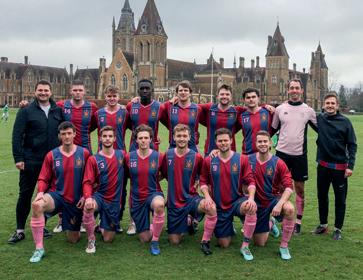


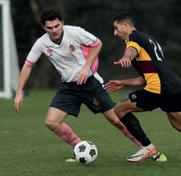
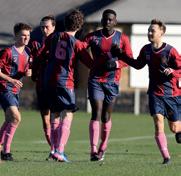
Charterhouse Basketball continues to go from strength to strength, both with the School team and the Old Carthusian side. The Charterhouse team are once again Public School Champions, winning the 2024 tournament by beating Bradfield College in the final, making them ‘back-to back’ champions. Old Carthusian Basketball has seen superb turnouts recently. Six Old Carthusian v Charterhouse games have taken place in the past year, with the series tied 3-3.
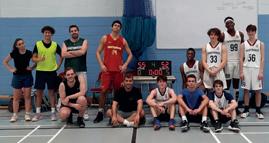
The OC Real Tennis Society is an active group who play the oldest ball game dating back before the 16th century. At the moment we have 4 main events in which OCs are invited to play:
1) Match v Petworth House Tennis Court which is played in January involving at least 5 pairs.
2) Match v Queens which is played at the end of February. This is a very popular event with at least 6 pairs being involved.
3) In April we have the Cattermull Cup which is a tournament for the old boys of various schools where we hope to enter 2 pairs.
4) Finally in October there is the Henry Leaf Cup which again is for the alumni of various schools when the very best amateurs play for the Cup. Over the years Charterhouse has had great success in winning this trophy several times.
I would be delighted to hear from any OCs who would be interested in joining us and playing in the tournaments.
To get involved, please contact Brian Sharp (R54) by BSharp318@aol.com or through Charterhouse Connect.
Charterhouse 55 – 52 Old Carthusians
Charterhouse 48 – 56 Old Carthusians
Charterhouse 60 – 53 Old Carthusians
Charterhouse 51 – 52 Old Carthusians
Charterhouse 52 – 53 Old Carthusians
Charterhouse 50 – 49 Old Carthusians
Old Carthusians who have taken part in the past year:
• Mike Stimpson (g04)
• Ernest Chow (G06)
• Branton Li (G11)
• Keith Tso (P14)
• Aidan Tang (S22)
• Sam Jencks (G22)
• Lucas Hui (g22)
• Will Worthy (G23)
• Phil Stimpson (L04)
• Tom McKay (P09)
• Tom Macfarlane (g12)
• Louis Renault (R21)
• Jeremy Ogbonna (H22)
• Ben Huang (g22)
• Harold Ng (H22)
Come join us on OC Basketball Charterhouse Connect.

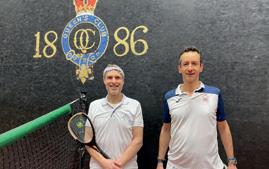
The OC Water Polo & Swimming Club compete against Charterhouse at least once a year in both swimming galas and water polo matches. We would love more alumni to join us in these events and to get together afterwards socially.
Join up through OC Swimming and Water Polo Club on Charterhouse Connect!
The OC Rifle Club meets to shoot both target and shotgun disciplines both socially and competitively. We enter several teams into the annual Public School Vets event at Bisley and have regularly shot against the School team. We meet to shoot clays at Cowdrey Park on an informal and social basis, with a debrief at the Duke of Cumberland. Novice shots more than welcome and instruction is available. We have an annual informal dinner with drinks beforehand which for several years has been hosted by Mark Garnier MP (P81) at the House of Commons.
To find out more, follow the OC Rifle Club on Charterhouse Connect.
OC Fives Club is sad to report the death of Ronald Pattison (V69), our good friend and a lifelong champion of Eton Fives and of Charterhouse School. A short tribute to Ronald can be found on the Charterhouse obituary pages; a line that captures Ronald well... “a lynchpin of the Fives community… a fine player and an evangelist for Fives as a social game – a way to form, develop and cherish friendships both on court and over a drink afterwards”. Ronald led OC Fives for decades, helped the School to coach pupils, supported the refurbishment of the courts and encouraged so many of us to play Fives.

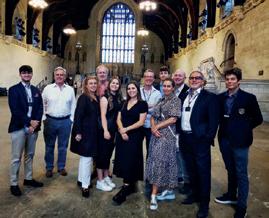
OC Fives club host a couple of social fixtures each year against the School and the Brigands. For anyone near Charterhouse, a number of OCs play weekly on Wednesday evenings with Brigands Fives Club, who extend a warm welcome to all; however rusty you may be, come along and rediscover the game. Age is no barrier with regular players ranging from university students to retirees.
Otherwise do find your closest courts and club through the Eton Fives Association (EFA).
To join OC Fives please contact Stuart Clarke (L94) or Hector Platt (B20) directly or through OC Fives Club on Charterhouse Connect.

OC Cross Country team competed in the 71st running of the Thames Hare and Hounds Alumni five mile race in Wimbledon Common last autumn. There was a tremendous turnout, with just under 200 runners competing in the race. Luke Doyle (S16) came 20th overall, with Bill Freeman (S16) and Ed Halford (P19) coming in 100th and 132nd respectively. OC Cross Country’s latest event was the annual OC versus current pupil “handicap” race at Charterhouse in March. Each runners’ start time is staggered depending on their ability, which generates a close competition: at least in theory! There was a significant turnout, with nine OCs and several current Charthusians running. Overall the current pupils won this year’s edition, with OC MacGregor Cox (V14) producing the fastest time. OC Cross Country’s next event will be the 72nd running of the Thames Hare and Hounds Alumni five mile race in Wimbledon Common in September. This year we hope to organise a few more casual runs alongside the standard three main races. Joining OC Cross Country is a convenient way to motivate yourself to keep up with your fitness goals and meet OCs from all different backgrounds and ages. We socialise after runs, often with a drink in the nearest pub!
Our first OC Badminton match took place at the beginning of December 2023 and we had a great time welcoming back old friends and cementing some ideas for the future of the club. Back at Charterhouse, the badminton squad is growing in strength. We played the inaugural ‘Charterhouse Cup’ here in February, with seven schools competing for the trophy. Whilst we didn’t win, our top pair played superbly and, given they’re still in the Under School, the next few years of badminton look set to be impressive. They have had a couple of training sessions at Surrey Sports Park with the University Squad, too – another way to develop their already impressive skill set. A group attended the All-England Championships in Birmingham mid-March as another way of enthusing our young players – it was the 125th competition, so there was more hype than in previous years.
As usual, badminton is curtailed in CQ due to the QSC being filled with exam desks, but we’re excited to return in September for the next step with the squad. If you would like to get involved, start playing or help hone the skills of our younger players, join the OC Badminton group on Charterhouse Connect.


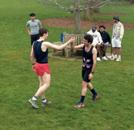
Interested in cross country? Email Luke Doyle (S16) on lukealexanderdoyle@outlook.com for further detail or join the OC Cross Charterhouse Connect.
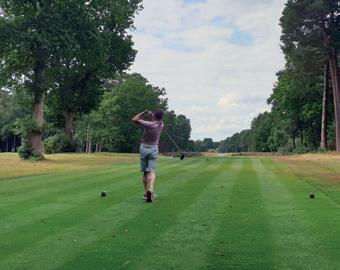
At the Halford Hewitt in April, captain Rob Manning (D89) fielded a highly experienced side with Harry Light (V13) on debut. In brutal conditions at Deal, the first three rounds were safely negotiated, setting up a quarter-final with Tonbridge. Tonbridge have won the Hewitt nine times since 1990, far more than the next best but, with one exception, our clashes have always gone to the wire. 2023 proved no different with two matches apiece and the deciding game all square playing the 18th. From Gus Giddins’ (W14) perfect drive, Light hit a superb shot under pressure to 20 feet. His opponent followed it with a wedge to eight feet, leaving Giddins with a putt he probably felt he had to hole. In front of a large crowd, he rolled it in, making his opponent’s putt suddenly seem twice the distance. The Tonbridge man missed, sending the Charterhouse supporters wild and their team into a semi against Epsom. The matches were again nail-bitingly close with the biggest scoreline 3&2. Julian Hill (W79) and Ryan McKinnia (L07) were four down at the turn but staged an astonishing comeback to prevail at the 18th, leaving Richard Caldwell (G95)/Jeremy Wauters (V09) and Giddins/ Light needing to win both their matches in extra holes. Unfortunately, it wasn’t to be and Epsom went through to the final where they were beaten by Loretto, who lifted the cup for the third year in a row.
In the over-55s Bernard Darwin at Woking in June, the OCs won for the seventh time. The team, led by Julian Hill, defeated Radley in the first round before squeaking past Eton with Andrew Bathurst (L81) and George Asprey (V85) prevailing at the 19th in the deciding match. The semi-final against Harrow was also close with Nigel Gray (H74) and Hill winning the deciding game at the 17th, extending their unbeaten record in the tournament to six years. The final against Wellington proved more straightforward with Asprey/ Bathurst and Patric Foley-Brickley (S76)/David (Jumbo) Royds (W78) winning comfortably.


Also at Woking in June, Wauters and Andy Hollingsworth (L98) took on the Alba Trophy, finishing in the top 10 in a 40-strong field.
Up the road at Royal Wimbledon, Simon Stilwell’s (g95) team featuring McKinnina, Richard Allen (B84) and Ben Schaafsma (H94) finished a very creditable third out of 32 schools in the putting competition.
In the autumn, Andy Hollingsworth’s Grafton Morrish team made it through two rounds at Hunstanton to set up a clash with Birkenhead, arguably the strongest school in the tournament over the past decade. Richard Allen (B84) and Alex Stanley (S99) won comfortably, but Wauters/Light and Hollingsworth/Rob Procter (L08) lost narrowly, sending Birkenhead ultimately on to the final which they won.
In our internal competitions, Michael Robinson (H68) won the scratch and Nick Beck (V71) the handicap at the Spring meeting at Aldeburgh, while at the Autumn meeting at the Berkshire, Julian Hill won the scratch and Nigel Gray the handicap. The Kenya Cup was won by Oliver Rose (F13). Congratulations to them as well as our other competition winners.
Our Spring meeting was at Royal St Georges on 10 & 11 May and the Autumn meeting is at the Berkshire on 6 September.
If you’d like to play in either or find out more about our fixtures, contact Barnaby Mote barnaby.mote9@gmail.com or through OC Golf on Charterhouse Connect.

Olivia Hurton (F15) is a poet, actress and scholar at Christ Church, University of Oxford. The Separation Ceremony was released on 1st February and is available at Amazon.com and Foyles.
What was the inspiration behind your poetry collection?
I’ve always written poetry and it was only when I began reading everything back that I realised that I was drawn to ideas of loss and separation. When I experienced those feelings, I always had to write, either to understand them or negate the loss and hold on to something by transmuting it into art. The collection explores this feeling in a myriad of ways – loss of love, innocence, time and the possibility of the future.
Inspirations always come through reading other writers. The epigraph to the collection is taken from Alfred Lord Tennyson’s In Memoriam A.H.H., a work that I came to much later in the writing process, but which charts that experience from intense despair to faith and hope in hauntingly beautiful verse. I saw the similarity between what we’d both been trying to do – to see the world through the eyes of heartbreak and find light in unexpected places.
Ceremonies and rituals are important in many of the poems. A poem in itself is a ritual, a way of emotionally responding, as a writer, to an experience. Throughout the book there are different types of ceremonies – revisiting a place to feel closer to a loved one, the rituals of falling into bad relationships, self-destructive cycles of behaviour, but also more hopefully, of personal renewal and seasonal regeneration. The glorious fact that in life everything can start all over again if you just let go.
What makes your poetry distinctive?
My poems are intensely musical. When you speak them, the words should come alive. I’ve always been fascinated by the way that sound carries a feeling. When I’m writing, words are like notes that I can draw upon to grab the reader by the heart.
What can readers expect?
There are a lot of surprises. The book was started just after I left Charterhouse and the final few pieces were written early this year, so it covers a lot of ground. There are tragic
C’est cauchemar! C’est cauchemar!
What a lovely nightmare you are!
In the moonlit room
In the starlit square
Our hands reach like teeth into the foggy gloom.
My dear, it’s too soon, too soon.
My heart is in my hands
And I’m choking on the bell of public clocks at noon.
Red wine nausea
Grapevine swoon;
The single rose will not prevail
The fortune teller whimpers
The street lamps fail.
You are so close yet the whole Hellespont divides us
Time a sunless minotaur in his awful maze tries to find us;
Like the colourless diamond
Of how I feel in this vacant room, It’s come and already it’s too soon.
I hear you through the cruelty of violet violins
Like the ones played in the music hall
With the desk and the curtains all blue.
I carved my name on the wall
I scarred it in your body just to see it through.
But you aren’t in there
love stories and lush reimaginings of classical mythology, to vignettes of midsummer madness in Oxford and gothic tales, all of which I hope will transport people heart-first into a world of rogues and romantics. Really though, these characters are a reflection of life as I have found it to be: full of joy, anger, delight, frustration and hope. You have to embrace it all, the absolute losses and the miraculous moments where things just work out. The collection encapsulates that capriciousness – euphoric or humorous poems punctuate whole sections of elegies; dark fades into light.
What is next?
Life is opening up in different directions at the moment and that is really exciting. Literature, art, theatre and film are my great passions so I always want to keep pushing those forms forward with my work, whatever way I can. The Separation Ceremony will always be special though, its pages are alive with the voices, places and people that have shaped how I see the world; it has taught me that sometimes it is enough to have had beautiful moments in the first place and that the things we love find a way of living on regardless.
Just some note in a drawer or two.
And my words fly into the mouth of how I feel
Soles of feet and ringed fingers
Are some childhood version of what is real
Webbed out in silky dew
Flowing flowing into
– it’s not you! But who?
Oh my darling I see your face
And it’s not you.
It’s too soon, too soon.
Black fell down on us like the sunsets of anarchy
That fighting my eyes
By blinding-blooded-guns;
I feel a linger, but not a touch
And yet again it’s all too much.
Your hand was scarlet.
Poor young girl walking the street
This is I
Not your Hamlet but your harlot.
And it’s just started.
Hurt me, make me feel.
Kiss me with dahlias
And like Dali draw me some sunset naked and surreal.
Give me something new
Not music notes
But make it kill
Make it real.
Anything – just tear me starless
Then let the darkness
Strangle me fatherless
Make me spring
Make me heal.
One second angel-wings like Juliet
Next minute in the virgin-tomb
All neon lights
Then the conversation slips –
In Death’s dreary kingdom we flicker beneath silent lips.
I’m sorry, it’s not me, it’s you. Death by the apocalypse moon. Then there’s silence.
Then there’s doom. Nothing but a solitary shadow of something impatient for affection.
A thousand sordid reasons for your lack of perfection.
We revolve like cracking vinyls
And you never say anything new
But in your veiny hand
Your grasp is dying
And it’s final,
It cuts like the soul of something true.
In our beauty we astound
In our promises we have drowned.
A profile of Luke Griffiths, 2YS, Duckites

Luke Griffiths made his professional debut for Surrey last summer. He shares how his journey in sport influences his life in School.
“I’m Head of School at Charterhouse and have gained recognition through playing cricket in recent years. I made my professional debut for Surrey in 2023 and also my England Under 19 debut. I joined School in Cricket Quarter of Fourth Form. Due to Covid my first experience of School was online. It was a weird experience meeting people in that way. I kept sane by playing cricket in the garden and on the local green!
Apparently, I was 2 weeks old when my parents took me down to the cricket club, Frimley CC, where my dad played for thirty years. I grew up watching him play every Saturday and started playing in the youth teams. Cricket is my passion. My grandad threw balls for me in the back garden from the age of 2 years old. I was loving life! I am a right-arm fast bowler. By Under 10s I was playing adult cricket and I joined Surrey at 8 years old playing a year up in the Under 9s side. At age 13 Director of Cricket Mr Martin Bicknell picked me up and I joined School with a scholarship. Since joining the Surrey Player Pathway at 8 years old, I have progressed through to the Under 18s. Last summer was my big breakthrough playing for Surrey.
Also a keen footballer, I progressed to playing district and county football from the age of 10 to 13 and then played first team football at School for three years. The coach encouraged me to play in goal as my cricket skills meant I had good hand skills and was well suited as goalkeeper.
Last summer I took part in the Super 4s, England’s Under 19 Trial Week and performed well, ultimately being picked for the U19 squad. We played Australia in the Youth Ashes Series. I played one one-day international and one test. I hope to be re-picked this summer. Playing international youth sport is so exciting. It’s something I had aimed for and I’m thrilled to achieve it. The coaching staff included Freddie Flintoff. It was inspiring to be surrounded by such legends. The Youth Ashes only happens every three years. India is on the horizon for this year if I am selected.
A lot of the lessons I have taken from sport have made me who I am and I carry them into other areas of my life. The simple things like good time-keeping, putting 100% effort into everything, they mould the way I go about academics and leadership. Boarding helps the cricket as I’m used to being away from home. It has made me independent. I think through cricket I’ve learnt how to deal with pressure. Pressure is a choice, it’s a good thing if you use it well. I bring this into my academic life at School.
It’s really natural for me to keep up with everything. I study Mathematics, Physics and Economics for A Level which are time-consuming and require a lot of effort. I write a plan each week. I have high trust relationships with my teachers. I enjoy my academics and love learning.
This year has been probably my most enjoyable year in House. We’ve had a new Head of House Mr Charlie Sparrow and we’ve become a co-ed House. It has added a lot of energy. We’ve created a lot of new events, for example House Bake Off and House
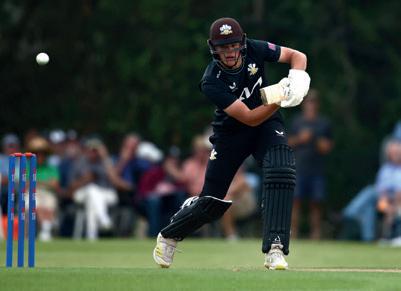
Cluedo. It has created an environment which is challenging and exciting to be a part of. House spirit has come a long way. We’ve had a lot of influence in this development and our Head of House has been incredibly supportive.
At the end of last summer, I had a scan which revealed a stress fracture in my lower back. I didn’t have any pain and it was a complete shock. I’ve had to focus on the positives, I haven’t been away playing cricket but I’ve been able to focus on my A Levels. Injury is part of sport! You can’t hide from the fact that you can get injured. I’ve had a sixmonth rehabilitation and lots of support from family, friends, the Surrey team and I’m pretty much back to full health. I’ve had physio and I’ve been working on my gym work. What I’ve found is that you can only control what you can do yourself. You can’t let something that you can’t control affect how you go about life.
My goal is to sign as a full-time cricketer for Surrey, hopefully this coming September and playing a few seasons as a professional cricketer.
I have an offer from Loughborough University to read Economics. I might go to Australia for a gap year and may play some cricket there. If a future in cricket doesn’t work out, I’d like to try and stay in sport and bring my twin passions together.
My ultimate long-term goal is to play for England. Last year gave me a taster of what this might feel like!
My advice to a Fourth is to throw yourself into everything at School. You won’t ever have the level of opportunity that the School puts on a silver platter for you. Whether it’s drama, art or sport, find a passion. Do everything until you can’t do anymore! You can then discover what makes you tick! Try everything, don’t leave a stone unturned.
My memorable moment was playing in the ISFA Football Final last year. Standing arm in arm with the First XI team, with the support of the whole School in the stands, it made it feel like we had won. That spine-tingling moment will stay with me forever.”
“ Ever since I saw Luke represent Surrey at U13 level I could see that he was going to have a big future in the game. What really stands out about him is his work ethic, love for the game and desire to improve. We wish him all the best for his career.”
Martin Bicknell Director of Cricket
By Tilly Nydes
of Theo, Saunderites
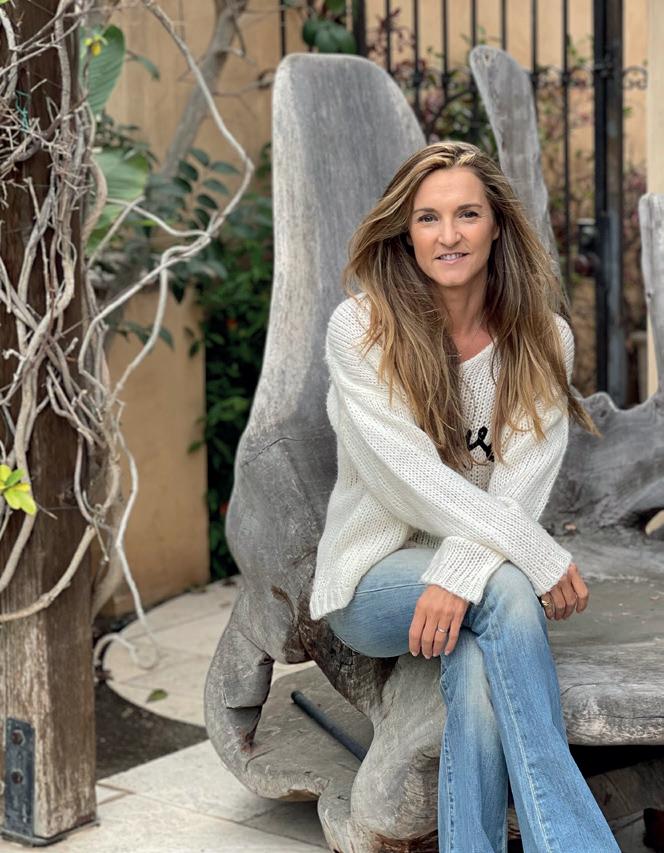
When our middle son first mentioned in late 2021 that he wanted to apply to boarding schools in England, my American husband was perplexed. In Los Angeles, where we lived at the time and where Theo spent most of his childhood, boarding school is generally perceived as a punishment. Some awful, far away place where wayward children get sent as a last resort, to be served gruel and sent out to break rocks in the midday sun. Or something along those lines.
As a Brit who spent many happy years boarding myself (at Woldingham, or ‘Wolditz’ as we affectionately knew it back in the 1980s) I obviously had more positive feelings about our then 14 year old’s suggestion. But I was still surprised he made it, and even more surprised when he kept pushing and pushing until his dad agreed to let him apply. He had no friends in the English system, and little idea of what life was like, either socially or academically, at the schools he was trying for.
What he did know that he wanted something very different to the Los Angeles day school system. He had a good group of friends. But the amount of politics that has made its way onto US High School campuses in recent years – from critical race theory, to gender and identity politics – can feel overwhelming for an adult, never mind a teenager. Irrespective of one’s beliefs, there is just too much politics in California schools, saturating every aspect of the curriculum and school life, to an oppressive degree.
On top of that, in LA schools were completely closed in person throughout the entire pandemic. It was basically one, long lockdown. Even worse from Theo’s perspective, all organized sport stopped dead as well, both inside and outside of school. No interaction with friends had been bad enough, but no football was taking things to the next level! By the time it was all over, Theo decided he wanted a school where maths was about maths, not race or gender; where he could play as much football as humanly possible; and where he could socialize with friends, try new experiences, push himself academically and nevermore be stuck indoors all day chained to a screen.
“ Thoughtful, responsive and experienced pastoral care. A fun, relaxed, happy, can-do atmosphere of camaraderie within the house.”
He worked hard for his UK entrance exams, which were very different from the US testing he was used to, and got in to several great schools. Charterhouse was the only one which we had not been able to visit in person when we flew over from LA to do our tours. It was nerve-wracking, accepting a place at a school he had never even seen. But in the end we chose Charterhouse for its combination of strong academics, its emphasis on football, and most of all its word of mouth reputation as a friendly and fun place where kids are prepared for the real world as much as they are for exams and university.
Having not visited the school, we didn’t really realise how lucky we were when Theo was placed in Saunderites. But from the very beginning, it was clear to us as parents that he was in the right place. His housemistress, Mrs. Allen, was very welcoming and kept in regular touch with us over his first few weeks. I joked with my LA girlfriends that I knew more about how Theo was doing and what was going on his life when he moved to a school 5000 miles away, than I ever knew when he went to school 5 miles away and came home every night. Right from the start, the house became a home for Theo, somewhere he felt comfortable and that he was proud to be a part of. The tutor system for academic support was also incredibly helpful, especially for a pupil like Theo, moving from a totally different curriculum and with ground to make up. He was expected to work hard, but also encouraged and supported to be successful. Football was always Theo’s passion, and he has been given tremendous opportunities to pursue that at Charterhouse. But he has also tried many other new things, from Duke
of Edinburgh expeditions to art trips, and made friends with a hugely diverse and interesting group of people, in his own house and beyond it.
We moved back to England as a family in the summer of 2023, after Theo had been at Charterhouse for a year. By that time, I already knew (and owed countless lifts-into-London to) several other Saunderites and football mums. My husband and I already felt a part of the community at this place, that our son had come to value so much. In his short time at the school, we have watched Theo grow in maturity and in happiness, and become more capable and confident in all aspects of his life, not just academics. In terms of academic rigour, the quality of the teaching he has received across the board has been exceptional – far beyond our expectations, honestly. But it’s the other, more intangible things Charterhouse offers that have been the stand outs for us. Thoughtful, responsive and experienced pastoral care. A fun, relaxed, happy, can-do atmosphere of camaraderie within the house. Staff that actually seem to like teenagers. (Thanks for everything, Matron.)
With GCSEs now looming, this will be a busy and inevitably stressful few months for Theo, and all his year group. But driving him back to school after Christmas, dragging suitcases and duvets back into Saunderites amid a sea of familiar, smiling faces, I felt confident that, however hard things might get, he was in the right place. As a parent, you can’t really ask for more than that.

At the beginning of Oration Quarter 2023 we were delighted to welcome Rosie Ngure as our first Scholar in Residence. This brand-new post was created to attract an inspiring academic to help develop a sense of scholarship and inquiry amongst our pupils. The post was fully funded by donations and we are incredibly grateful to those donors who made this exciting idea a reality.
Rosie joins us for the 2023/24 academic year whilst also continuing her PhD in Creative Writing at The University of Surrey. She tells us more about her work, her reasons for joining Charterhouse as our first Scholar in Residence and the impact our pupils are having on her research.
“I was excited by the opportunity to come to Charterhouse and especially, to work alongside the pupils in the various activities I’m involved in. I work closely with the English and History Departments as well with the Wellbeing team. The English and History beaks are already doing great work and when I joined, I brought in a different voice to widen the pupils’ perspectives and diversify their views. To me it is joy.
My PhD research focuses on Black and African Women in Literature and the use of Female Narrative Voice to Inscribe Humanity and Heterogeneity. I am studying those whose voices were invisible in the publishing industry in the 1960s and 70s, but they weathered the storm, and their endurance helped to bring about the rise and openness of feminism in Black and African female literature. I am currently in the second year of my PhD and working with our pupils has provided me with extra help in my research as I have to research their books as well as my own. It broadens my understanding of literature and so for me it’s a win-win.
The team at Charterhouse have been fantastic and welcoming. I have been collaborating with the English Department to teach The Crossing by Manjeet Mann and A Streetcar Named Desire by Tennessee Williams. The pupils enjoyed a different approach to craft analysis and they gave great feedback which help to broaden their understanding of variable voices in creative writing which is what literature is all about. My role as the Scholar in Residence is to
“ My role as the Scholar in Residence is to encourage pupils to think from different perspectives, help them interpret these books and to understand and question why it might be important and valuable.”
encourage pupils to think from different perspectives, help them interpret these books and to understand and question why it might be important and valuable.
Last Quarter I taught the Creative Writing elective and I had a fantastic group of pupils who were very engaged. My aim was to understand their perspectives and interests and to support their work in film, poetry and creative writing. I wanted all pupils to gain and learn from my elective. I studied a lot of these areas in my Master’s Degree and I am able to use the knowledge I gained there to help the pupil and to enable me to refresh my skills in this area.
Another major part of my role as Scholar in Residence is to support the Equality, Diversity and Inclusion (EDI) work within the School. I am really passionate about helping the next generation to know it’s ok to express themselves irrespective of their background, gender or race.
I was concerned when I joined the School that EDI was a tick box exercise but since being here, I’ve seen how important it is to Charterhouse, and how the School makes EDI part of everything that we do. My role in EDI work has been quite fluid and I’ve relished the freedom to scope out ways I can add value and impact, such as bringing in speakers for Black History Month. Recently I was involved in reviewing all academic subjects to understand how they ensure equality, diversity and inclusion are acknowledged within their subject. It was good to see how beaks and Heads of Department are constantly trying to incorporate EDI into their work. For some subjects this is much easier than others; Maths and Chemistry for example, are much trickier and I have been so pleased to see colleagues who are thinking outside the box about ways we can incorporate EDI.

I am excited about the rest of this academic year where my focus will be on my Creative Writing elective and supporting the English Department. I will also continue working on EDI with the Director of Wellbeing to help offer solutions and knowledge and to identify experts who could help us in a variety of areas. Outside of creative writing one of my great passions is Reverse Mentorship, the main focus of which is to overcome our fear of difference through increased communication and improving understanding of others. I am very excited that this term I get to do more of this within my role.
Next academic year I will be focusing on completing my PhD. My work at Charterhouse has greatly helped my reading for my PhD and I have been making notes this year on the books we have studied, which I will use towards my PhD.
I am delighted to be the first ever Scholar in Residence at Charterhouse and I hope that other academics will be interested in this role, as it can help your research and well as helping pupils to learn more about different cultures and voices.

By Ryan Ying First Year Specialist, Lockites
“ The Greenland shark possesses the greatest lifespan among its fellow vertebrates, averaging at around 400 years.”

Death. It is a sensitive topic to some, a source of fear for many, yet patiently waits for all of us at the end of our respective journeys. As mortal beings we have learnt to accept this fact while we continue about our short, pathetic, and fleeting lives, before passing on and eventually being forgotten within the span of decades –what is but a microsecond compared to the life spans of beings such as stars, or even the universe itself.
As a result, the dream of immortality is one that is shared universally by different cultures and religions alike, throughout the brief history of humans. Perhaps most notably in Chinese history, rulers and kings were infamous for being obsessed in the pursuit of eternal life through obtaining the “pill of immortality”, a fabled medicine said to grant the user everlasting vitality and even bring the dead back to life. Although the experiments failed, it resulted in the accidental invention of gunpowder, and even tofu (according to some legends). Ironically, many emperors such as Qin Shi Huang died a premature death as the pills often contained high concentrations of heavy metals such as mercury or lead. Today, most people seem to have abandoned what they believe is a naïve and hopeless fantasy, without realising that nature’s “pill of immortality” exists discreetly among us, hidden tantalizingly out of sight.
In the murky, cold depths of the Arctic waters off the coast of Greenland, a lone shark blindly meanders. Its eyes have been rendered to a near blind state by worm-like parasites, and its skin is cracked and wrinkled with age. Indeed, the Greenland shark possesses the greatest lifespan among its fellow vertebrates, averaging at around 400 years, although some Greenland sharks have been recorded to be over 500 years old. Their astounding vitality is largely attributed to their extremely
slow rate of metabolism. In fact, the Greenland shark seems to lead a rather slow life in general – its swim speed is one of the lowest across all fish species at 1.22 km/hour, paradoxically slower than the prey it consumes. Even before the Greenland shark is born, it has to spend a gestation period of 8 – 18 years before being let out of its mother’s womb.
The Greenland shark, along with animals such as lobsters or plants such as aspen trees, are all examples of organisms which display negligible senescence – meaning that their health does not deteriorate as their chronological age increases. As long as they have enough food and avoid predators, they can theoretically live forever. In humans, the body weakens with age, and becomes more susceptible to disease and injury. As surgeon and author Atul Gawande puts it in his book Being Mortal, “Old age is not a diagnosis. There is always some final proximate cause that gets written down on the death certificate – respiratory failure, cardiac arrest”. To be clear, there is a stark difference between senescence and aging –senescence is aging in the biological sense, the gradual deterioration of the bodily functions, whilst aging is but the increase of the time spent alive for an organism, without the implications attached. This is important to consider when dealing with non-senescent organisms which age, like all living organisms, but do not senesce.
Why most living organisms experience death is a topic under heavy debate even now among biologists, with many theories being developed about it. One of the most iconic theories is developed by Sir Peter Medawar, a Nobel prize laureate most known for his work on organ transplantation. His theory of senescence published in 1952 used the idea of genes being the base unit for natural selection as a foundation for his reasoning – the goal of all sexually reproducing organisms is to act as carriers to spread their genes – such that the life of the organism is only a second priority to the survival of its genes. Once an organism has reared offspring with the same genes as itself, its life or death matters not. To summarise his words, he theorises that the age of death is greatly related to an organism’s “reproductive value”. Since organisms tend to reproduce as soon as they reach sexual maturity, any potentially lethal genes (such as one that would cause cancer) that act later during the organism’s stage of life would have much less of an effect on the organism’s ability to reproduce and bear children, allowing the spread of their lethal phenotypes within the species without significant consequence. Therefore, older organisms have a lesser “reproductive value” because they would have already had many offspring and spread their genes, and any genetic disease which were to infect them would have no repercussions in the long run.
Indeed, the secret to immortality lies within the genetic composition of the organism. The one thing which all nonsenescent organisms have in common is the ability to indefinitely replenish and repair their DNA and thus cells. This is because one of the main theorised reasons for how we age is through accumulative damage to the DNA (note that this is different from mutations, in that it affects the chemical structure of the DNA, not the base pairing sequence). To explain in greater detail, all cells except for embryonic stem cells are unable to undergo cell division indefinitely. Eventually, they reach what is known as the Hayflick limit and enter a state of apoptosis, a programmed cell death where the immune system will kill off the cell. The Hayflick limit itself is defined by the length of telomeres in each chromosome the cell contains: Telomeres, which are essentially repetitive non-coding sequences of DNA, can be found at both ends of a chromosome, where the genes can be found in between. Due to the nature of cell division, every time a cell divides a portion of their chromosomes are damaged. Therein lies the main function of telomeres – they do not code for any proteins, but rather act as a form of protection against the damage caused to the chromosome. Unfortunately, the entire length of telomere will eventually run out after enough cell divisions, reaching the Hayflick limit and causing the actual genetic coding material of the chromosome to be damaged.
This field of genetics is still a very relevant and popular field of research today. Particularly in the context of health and medicine, this research is crucial for understanding and solving issues such as cancer. Cancerous cells produce telomerase, an enzyme which stimulates the production and repair of telomeres. This essentially

removes the Hayflick limit, allowing them to reproduce indefinitely and out of control into a large tumor. One of the proposed treatments of cancer involves the inhibition of the telomerase enzyme, effectively halting the development of the tumor and preventing its spread throughout the body. On the contrary, stimulating specifically the stem cells in the human body to produce telomerase can also benefit our health greatly. Known as telomerase therapy, synthetic mRNA with the coding sequence for telomerase is injected into stem cells, causing the telomerase enzyme to be produced through protein synthesis. This method of replenishment is shown to reverse the effects of telomere shortening in stem cells by 10 years in a single treatment, whilst having a low risk of mutations
leading to cancer as the telomerase is only being produced for a brief amount of time per dose of mRNA.
So could telomerase therapy be the key to eternal youth? It is impossible to tell as of now. What we can be sure of, however, is that the development and research into this field will continue until a conclusion can be made. As of today, scientists have already successfully manipulated the lifespans of animals such as the C. Elegans roundworm, doubling its lifespan and causing it to age slower just by the alteration of a single gene. Although the clinical trials for humans have yet to begin, the prospects are promising and they are likely to have high success rates. Soon, it may be that death will no longer be a threat, but rather, it will be us humans that are waiting patiently to die. The Greyhound

We welcomed Andy Thomson to Charterhouse in OQ 2023 from Highgate as Head of Design Engineering. We spoke to him about how Design Engineering and Technology can enhance the future careers of pupils as well as Andy’s plans for the department.
Design Engineering gives young people the opportunity to explore where their creativity can be realised in a practical way. The beauty of the Design Engineering curriculum is that it is constantly changing and evolving. In the past it was more fixed; woodwork, food technology etc. but as we now move in the fourth industrial revolution, our pupil’s skills and knowledge need to reflect the world around us. My role at Charterhouse is to make a space and a curriculum which inspires and prepare pupils for today and tomorrow’s world.
I learn from the pupils; they bring in new technology or ideas and we explore it together. The pupils, the department and I all grow exponentially quicker as we are learning together. I am as excited as them about new discoveries and I enjoy iterating their ideas together.
The creative arts are often a home for pupils who want to pop in and tinker in a relaxed atmosphere. They gain confidence and the skills they learn can be transferred into other parts of their schooling and life such as; empathy, teamwork, entrepreneurial and communication skills. In today’s society we need problem solvers and creative thinkers, and design engineering is a vehicle for students to be inventive and to move forward into their careers thinking about designing solutions, materials, and products. It’s a subject which has a real impact on the world.
My focus coming into Charterhouse as the Head of Design Engineering is to ensure our pupils achieve the best results they can. Although exam results are not the end point, they need them in order to access the next step beyond school. With good results, anything else falls into place from clubs societies, competitions and partnership opportunities. Our pupils studying the subject will have a portfolio of items which is really useful for university and job applications as it demonstrates application of knowledge and problem solving. Everything we do is about context; it is all linked into the outside world. All the skills we teach are relevant in future careers.
Across the school we aim to ensure our pupils are future-ready. The future workplace and career opportunities will change hugely and our pupils will go into jobs that don’t exist yet. It is vital we focus on teaching them key trends as well as skills. At the moment the key trends in our field are technology, user centred design and sustainability. In technology; robotics, 3D printing and AI are the key areas which are booming and my aim is to continue providing pupils with opportunities to develop their knowledge in these these topics. When studying user centred design, we focus on the rationale and empathy as to why something has been designed. It has to solve a problem or have a reason why we are designing an item. The final trend is sustainability, we need to understand more about our technology

as we become more removed from it and throw away in our culture. I think the trend will be for companies to take more responsibility to repair and reuse rather than replace. It is our responsibility to produce citizens who are aware of all three of these trends.
The Design Engineering department is also supporting the local community. Through partnerships with local primary school teachers, we are facilitating robotics lessons to help them build their skill sets. Additionally, we are hoping to support the local Repair Café which is run by Rotary Club with support from Godalming council.
When I was at school, I always had an affinity for STEM as well as Sport as I was privileged to represent Scotland at Rugby. Design & Technology at school gave me a home and a different trajectory. Without it and my sport, I may have gone down a different path. I want to offer this same experience to our pupils. I feel I am privileged to work with young people and to see where life takes them.
Being a small cog in their journey, that’s where I get my validation. Every day is different and I get energised by the pupils.
If you have links to Design and Engineering, please get in touch. You can see some of the great things which are happening in the department via the social channels below:
@charterhouse_de
@charterhouse_de
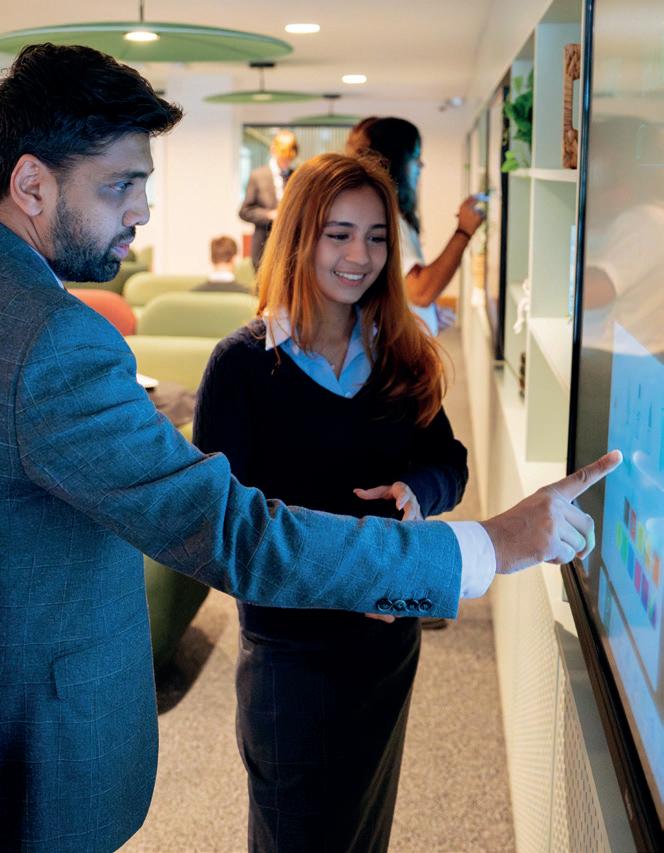
We are delighted that our business, leadership and entrepreneurship centre, the Hub is now open. A boardroom, a tech-rich seminar space, group working pods and a 200-seat lecture theatre all combine to create an environment that mirrors the type of modern open-plan flexible spaces seen in universities and business, providing opportunities for collaboration, risk taking, presentations and team-work. The Hub is already being used for our Future’s drop-in sessions on university applications and job interviews, the Entrepreneurship Diploma, Pupil Action Committees, societies and FutureU PSHE sessions. We are really excited to see this new space in use and want to extend our gratitude to the parents and OCs who donated £2.9 million to help make this idea a reality.
The School’s FutureU programme is a central element of the Carthusian experience, aimed at making our pupils amongst the most future-ready young adults in the world. Our pioneering programme provides every child with the opportunity to develop the skills, professional knowledge, experiences and mindset required that will enable them to thrive in our fast-changing world. Soft skills such as creativity, emotional intelligence, and adaptability will be highly valued in the future job market.
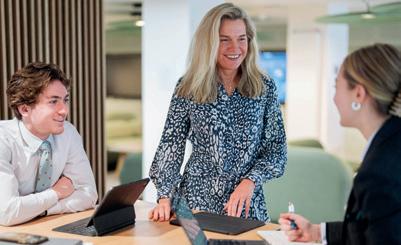
1. The Charterhouse 10 transferable skills
2. Life Hacks: increasing professional and personal effectiveness
3. An Entrepreneurial Mindset
4. Understanding the World of Work
5. Personal Brand Development
In September 2023, we became the first school in the world to offer pupils an Entrepreneurship Diploma accredited by the Institute of Enterprise and Entrepreneurs (IOEE). Specialists have the opportunity to gain a level 3 professional qualification in Applied Entrepreneurship. In addition, upon successful completion of the CED, pupils will gain sixteen UCAS points. This is the first time such a programme has carried UCAS credits. Delivered by a blended programme of taught classes, supplemented by case studies and guest speakers, framing theoretical learning within real-life applications. AI technology is used to provide advice and feedback to students throughout the course.
“ The addition of AI learning is a particularly significant innovation. We already know that job applicants come into increasing contact with AI during the first phases of the recruitment process. Providing our pupils with an initial framework for how to begin working effectively with AI will be a huge support in the years ahead.”
Mr Sandip Patel Head of Entrepreneurship
The Charterhouse Entrepreneurship Diploma forms an important part of the School’s commitment to preparing all pupils as completely as possible for their future.
The most competitive universities such as Oxford, Cambridge, Imperial, LSE, Durham, St Andrews, Edinburgh, Bath, Warwick, LSE, and Kings have more applicants than places. They are therefore much more selective and it is sometimes difficult for pupils and parents to understand that they generally require pupils to have predicted grades higher than published entry requirements. For example, Economics at LSE is A*AA, but they receive 3927 applications for 263 places, and therefore many pupils with higher predictions will not receive an offer. Conversely, the less competitive universities often accept pupils with grades below their published entry requirements. Our Futures Team regularly speak to Admissions Officers at universities and make sure we have relevant data on application statistics to advise pupils on what can otherwise be quite an opaque system.
The 2023 leavers took up places at top universities in the UK, US and around the world. Seven pupils earned their places at Oxbridge, with a further four at Imperial, five at LSE and five reading architecture at top universities including Cambridge and Edinburgh. Exeter was the most popular destination, followed by UCL and Durham. Three pupils continue a longstanding tradition of Old Carthusians studying Real Estate and will be attending Oxford Brookes, one of the top courses of its type. Overseas destinations continue to be popular, with pupils taking up places at Columbia, USC, USSB, McGill, Toronto, Bocconi and IE.
> Exeter > UCL > Durham > Oxford Brookes > KCL
> Business
> Politics, International Relations
> Biology, Chemistry, Bio Medical
> Modern Languages
> Engineering

A triumphant year with new ideas and performance opportunities: 2023 has proved to be a year of change and development, growth and expansion, triumph and achievement.
Into Cricket Quarter and there was no let up! Musical experiences continued thick and fast, with musicians travelling to Winchester and, once again, Guildford Cathedrals for further performances. This time, a piano trio to Hampshire to participate in the Cathedral Concert Series and then Junior Chapel Choir joined the Girls’ Choir down the road to celebrate the Eucharist for St Mathias. Further performances came even closer to home as Big Band travelled into Godalming to perform as part of the ‘Music in the Park’ series, performing to the gathered masses for a couple of hours one Saturday afternoon. Concerts at School continued on with Evening Recitals and the eclectic Ensemble Concert taking stage allowing a myriad of performances to take place. Singing at Charterhouse continues to grow and develop and we were thrilled to welcome Mr Alex Ashworth to Godalming to adjudicate on the annual Singing Prizes. Most of said pupils, and more (!), came together for the Prep School Choral Day, this time in collaboration with pupils from Hoe Bridge, Edgeborough, St. George’s, Windsor and Aldro for a performance of Mozart’s Requiem. In one of his final times up on the rostrum, Mr Mark Shepherd led a delightful and enjoyable afternoon of participation by all involved.
nurture of Charterhouse music. If this wasn’t enough, a surprise performance of one of his favourite pieces – the Liebestod from Wagner’s opera Tristan und Isolde, arranged for the occasion by Head of Academic Music, Dr Russell Millard – was given by an ensemble of current and ex-pupils, alongside colleagues from the Music Department. The solo part was performed by singing teacher Mrs Claire Sutton-Williams, who gave an exceptionally moving account of one of the most challenging soprano roles in the repertoire. It was an extremely special end to a most memorable concert.
And so to welcoming two new members of staff to the department:


If it happens twice, it becomes tradition – correct?! Let’s call it, therefore, the traditional Eve of Carthusian Day Concert was once again CQ’s musical highlight. Typically, as a chance to showcase the talents of our soon-to-be OCs, this year featured concerto performances by Justin Wang (L23) and Adrian Choy (L23), performing Mendelssohn’s G minor Piano Concerto and Brahms’ Violin Concerto respectively. Tricky repertoire for both soloist and orchestra (not to mention the conductor!), everybody rose to the challenge and this was a concert of real skill, virtuosity and exhibition. The playing and musicality from all involved was truly exceptional, a most fitting way to thank and celebrate Mr Mark Shepherd for his years of devotion and
to hear that congregational practice is a continual highlight in the week of any member of the School. Thursday Choral Evensong has been enjoyed by choir and congregation alike each week, Schola taking their vocal talents off to Chichester Cathedral just before half-term. To cap it all off, the calendar highlight of House Singing was soon upon us, and we were thrilled to welcome Mr Tim Carleston to adjudicate. In a change to usual proceedings, and led by Charterhouse Rock School front man Mr Ian Kelley, a live staff band accompanied each House in their performance. This time around, Sutton came out on top with their rendition of Cheap Thrills (Sia).
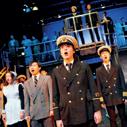

a very warm welcome to Mrs Katie Harris, Head of Strings, and Mr David McKee, Head of Music. Already, in their short time with us thus far, huge impacts have been made and we are all very excited for the future of music-making at Charterhouse.
OQ began with a wonderful Evening Recital given by Music Scholars with some of them combining later on in the term to accompany Senior Chapel Choir celebrating the feast of All Souls, the service including Fauré’s Requiem. Mr McKee has continued to invigorate singing at Charterhouse: Junior Chapel Choir is very healthy in number, a new Schola Cantorum has been created, and OCs will be happy
The second half of Quarter was dominated by Piano Prizes and the usual frantic yet musically wonderful Christmas run-in. Adjudicated by Mr Kit Perona-Wright, Piano Prizes was another successful and competitive evening, with a real array of performances. Huge thanks to our piano VMT team for their tireless work; prizes went to Oscar Bonnefoy (V) and Claire Wang (Su) in the Junior and Senior categories respectively. This year’s Christmas festivities included a Jazz Concert, Candlelit Carols, three Carol Services at School and a further one at the London Charterhouse, finishing with the Christmas Concert involving Symphony and Chamber Orchestras, Flute Ensemble, Concert Band, Wind Quintet and both the Parker and Coltrane saxophone ensembles! Too much to write about, not enough space here (!), but highlights included Chamber Orchestra giving a performance of Corelli’s Christmas Concerto, movements interspersing choral items at Candlelit Carols, Rock School strutting their stuff at the Jazz Concert and an orchestral performance plus live screening of The Snowman at the Christmas Concert. A well-earned end of term break was much needed and deserved, but what a term it was; full of musical activity and excitement, most encouraging for the future.
Jamal Sutton Assistant Director of Music

A superb season for boys’ football across the board, however the highlight must be the 1st XI, who not only won the Hudl League but also made the ISFA Cup Final for the first time since 2011. The evening at Stadium MK was a fantastic experience for the whole School and the support the pupils offered to the team, particularly at the final whistle after a tight 1-0 loss, made for a special evening that will live long in the memory of players and spectators alike.
The season highlighted the promising future of girls’ football at School. With the 1st XI acting as role models to the new Under School footballers, bringing home wins and holding heads high after losses has been crucial. The Junior girls’ football squad ended the season unbeaten, which is a huge credit to their character and attitude.
We are now fielding 16 boys’ hockey teams across the U14-U16 age groups in a tough circuit, winning 36% of fixtures. U14As provided the season highlight, gelling together quickly and producing a fantastic season of hockey only losing one match to the eventual season winners. This season’s individual highlight goes to Caspar Beyer’s (P) for his selection to the Great Britain EDP squad.
Girls’ hockey has continued to grow at an exhilarating pace with 11 teams
playing 106 fixtures. In addition, there was a flourishing House Hockey Tournament that allowed players of all abilities to represent their House.
What a season girls’ netball had with 198 girls representing the School in 22 teams playing 193 games over a 10-week period. The buzz around the courts on training days and matches was electric. The girls’ desire to improve, the drive to win and the cohesion of the squads quickly became evident.
The 1st XI had high hopes going into the 2023 cricket season. Their Cowdrey Cup campaign got off to an excellent start with a good victory at Radley, but defeats against Tonbridge, Harrow, and Wellington left us floundering around near the bottom of the league. The Eton match was cut short where we bowled very well to have them 150-6 before the rains came. At times the team lacked a ruthless streak, epitomised by defeats against the ACA Academy and Bede’s. We did rally towards the end with wins against Portsmouth Grammar, Westminster, and an astonishing victory at Cranleigh.
Charterhouse athletics had a strong season under the excellent leadership
of Jesse Jabaru (R) with our biggest team of Seniors ever. The Inter Boys had strength in depth with over 25 athletes regularly training. Thomas Bateman (S) showed his talent right from the start in the 200m.
The 2023 tennis season will be remembered for a long time, a season which saw record numbers of players involved in matches, record win percentages, and lots of fun. A special mention must go to the exceptional doubles partnership of Tom Kinmont (D) and Amelia Drayson (W). Tom has represented the U14A, U15A and Boys 1st team during his time at Charterhouse and has been awarded sports colours. Amelia has also had an outstanding year on both the racquets and tennis courts. As a doubles pair, they have hardly dropped a set all season, despite competing against the best teams on the school circuit.
This has been a highly successful year for basketball. The club has set records for most basketball games played, most games won, fewest games lost, and highest winning percentage for a year. U18s: Played 23 Won 20 Lost 3 The U18 team deserves particular praise for winning the 2023 Public Schools’ Basketball Tournament. Credit goes to the outstanding leadership shown by captain of basketball Will Worthy (G).
This year saw our largest swimming team take part in fixtures against Harrow, Eton, Bradfield, Churcher’s College and St John’s Leatherhead. Memorable swims came from Ella Fox (F), who won most of her Individual Medley and Butterfly races, but her win against Harrow’s boys was much to be admired. Other wins came from Timothy Tso (V) in the 50m Breaststroke, Sander Marshall-Lee (S) in 50m Butterfly, and Arina Maslova (C) in the 50m Freestyle. In March, eight swimmers were selected to compete at the prestigious Bath and Otter Cup, a national event held at the London Aquatic Centre.
The first big win for the U18 water polo team came when they played Churcher’s College, winning 8-4, with goals from Captains Nero Jones (H) and Jack Tenenbaum (D). In the ESSA Schools National Water Polo League, the U18 team put in their best performances yet to progress through to the Plate Semi-Finals. For the first time, an U15 Mixed team entered into the ESSA National Schools Tournament, featuring Ella Fox (F) and Chloe Musk (W). The team qualified for the National Bowl Final, coming away with fourth place.
Amelia Drayson (W) is the U18 Racquets National Schoolgirls’ Singles Competition (The Judy Angus Cup) champion. Amelia’s runs of serve and ability to kill a rally with her excellent shot placement down the left-hand side wall proved decisive. In the U15 Boys Doubles Competition (The Peter Gray Cup) Alex Magliana (D) and Ollie Webster (D) reached the Quarter Finals. At Christmas Ollie Webster again reached the Quarter Finals of the U15 Boys Singles Competition (Jim Dear Cup), whilst Harry Baker (V) had a good run in the Renny Cup (U18), reaching the last sixteen.
We said farewell to our long-time fencing coach Michael Johnson who retired after over a decade at School. The fixture list was back up to full capacity and matches took place both home and away in excellent spirit
with victories against Westminster and Tonbridge School. The annual fixture against the OCs proved to be a very closely fought event. Notable performances at the Public Schools’ Fencing Championships from Jamie Summers (Su) coming sixth in the Junior Epée, Justin Jin (S) in the Junior Foil and Charlie Jorgeson (V) in the Junior Sabre.
The Charterhouse Eton Fives team had an exciting season, marked by significant growth and development. The U14 squad showed great promise, and older players made progress, making great strides in shot selection and execution. It was particularly exciting to see some of our U14 pairs perform so well at the Nationals in March.
Our squash players participated in over 30 matches in a highly successful season. The 1st V played in some of the most competitive tournaments in the country. They maintained their position in Group 1 at the prestigious Roehampton Squash Tournament, and they demonstrated great adaptability when playing in the Epsom Doubles Tournament. Finally, they progressed to the 2nd round of the Squash National Tournament, where they faced stiff opposition from Epsom College and Harrow School. The U16 and U14 V boys’ teams put on commendable performances in the Nationals. The U15 girls’ team delivered an impressive performance against a formidable Benenden side.
A successful year of golf with over 20 fixtures and events. The Junior and Senior teams have been competitive and enjoyed wins over Winchester, Cranleigh and Lord Wandsworth. In the HMC foursomes, our golf team got to the semi-finals of the South Central Region, losing matchplay, Charterhouse reached the national finals of the Plate competition held in Lincolnshire. Our Junior girls also took part in Cranleigh School’s Invitational competition with Jemima Jones (Su) taking 1st place in the U15 team category. In the Charterhouse singles competition, Robbie Marshall (S) won the Peter Alliss Trophy.
Under the super-committed leadership of Dylan Lin (G) and Aaron Yang (P), Charterhouse badminton played more matches than ever, with fixtures against Winchester and Wellington added to the usual schedule. For the final match of this year the squad took on a formidable Epsom squad with our 1st pair winning all their games. With amazing talent coming through, the longer-term future of the sport is strong.
The highlight of the year for the School equestrian team was a nailbiting finish, to take the top prize at the Hurst College National Senior Schools Jumping Championships. The Championships were hosted at the All England Jumping Course Hickstead. Twenty-two teams jumped a preliminary round with the top 11, including Charterhouse, going forward to jump a second round in the main International Arena. The team finished with a clean sheet after three members posted faultless rounds, meaning they had to jump-off against the Hurst College Red team. Georgia Stephens (V) went forward to jump, producing a fast clear in 40.02 sec to take the win.
In the Council for Cadet Rifle Shooting (CCRS) Commonwealth Matches this year, our cadet shooting teams won 16 medals and three trophies. In a surprising turn of events, the Bs managed to trounce the As in the CCRS .22 Team Competition (formerly known as ‘The Country Life Competition’). Max Sheridan-Oliver (P) has been selected for the GB U19 Team, and Hermione Grindon (N) has been selected for the UK Cadet U17 Team. At the Schools Imperial Meeting, the team performed outstandingly, coming in at 2nd place in The Queen’s Regiment Cup and The East Surrey Bicentenary Bowl. Moreover, out of 35 schools in attendance, Charterhouse placed 10th. Very impressively, Max Sheridan-Oliver and Hermione Grindon also gained places to represent England in the BSSRA National Finals in the C and B teams respectively, thus earning their ‘England Colours’.

With sadness, Charterhouse reports the passing of the following Old Carthusians, notified since February 2023. OCs are listed chronologically according to their year of leaving.
H37 MCALPINE, Kenneth aged 102 on 8 April in 2023
W40 HACKETT, David aged 101 on 16 February 2023
W40 MARX, Francis aged 100 on 14 April 2022
R42 CRAWFORD, Douglas aged 99 in 2023
H42 STIVEN, Ian aged 98 on 24 March 2023
V42 VYVYAN-ROBINSON, Cecil aged 93 on 14 April 2022
V43 HICKS, Peter aged 97 in September 2023
g45 CATCHESIDE, Robert aged 82 on 7 November 2011
H45 CHEVIS, William aged 95 on 1 September 2023
V45 HELME, Antony aged 93 in 2022
S45 THORMAN, Alan aged 96 in 2023
D46 BLACKLOCK, Michael aged 95 on 9 October 2023
B46 COOPER, Adrian aged 78 on 30 January 2008
W46 CORTIS, Harry aged 94 in 2023
V46 DIBB, Peter aged 75 on 20 June 2003
G46 GLAUSER, John aged 93 on 15 June 2022
V46 GOTTLIEB, Stephen aged 94 on 23 August 2023
S47 BAKER-CARR, Christopher aged 83 on 25 October 2012
H47 MCGUFFIE, James aged 92 on 22 August 2023
W47 NEWELL, John aged 93 on 10 June 2023
H47 TICE, James aged 94 on 19 December 2023
S48 ARCHIBALD, Malcolm aged 91 on 14 January 2021
S48 FINLAISON, Bruce aged 93 on 15 October 2023
D48 MILLER, John aged 93 on 24 February 2024
W49 LAW, Richard aged 91 on 22 May 2023
W49 MARKS, Clive aged 92 on 24 August 2023
P50 DONNE, John aged 95 in 2023
S50 FAIR, Nick aged 90 on 8 September 2023
S50 HOUSDEN, Edwin aged 91 on 22 July 2023
B50 JENKS, David aged 90 on 27 January 2023
W50 LYONS, Bill aged 90 on 21 September 2023
B50 SUMMER, Graham aged 90 on 31 March 2023
S50 WOOLLEY, Ian aged 91 on 24 October 2023
L51 BRISCOE, Cedric aged 87 on 18 May 2021
P51 BRISTOWE, Gerald aged 89 on 15 January 2024
V51 BROOKES, John aged 86 on 1 March 2022
D51 JACOBS, David aged 89 on 6 February 2023
L51 PAYNE, Edward aged 90 in 2023
L52 MITCHELL-INNES, Alistair aged 89 on 18 September 2023
G52 PARKER, Neill aged 90 on 4 July 2023
G52 VON BETHMANN-HOLLWEG, Derek aged 88 on 25 April 2023
G53 SAUMAREZ, James aged 85 on 28 May 2023
L53 TEMPLER, James aged 87 on 14 December 2023
S53 THOMSON, Peter aged 88 in 2023
P53 WELLS, Peter aged 86 on 7 February 2023
P54 BARNARD, Ian aged 87 in 2023
V54 DOXAT, Nigel aged 86 on 18 February 2023
S54 GRAHAM-TAYLOR, Richard aged 86 on 7 July 2023
R54 LAWRENCE, David aged 85 on 19 December 2021
P54 SHAW, Patrick aged 84 on 6 August 2022
L55 EDWARDS, John aged 86 on 2 November 2023
R55 EVANS, Alan aged 85 in 2023
R55 GOWER, Nigel aged 85 on 14 January 2023
G55 GRAHAM, Angus aged 86 on 2 November 2023
R55 MACFARLANE, Craig aged 79 in April 2017
H55 WINTHER, John aged 85 on 24 February 2023
R56 COSTAIN, Peter aged 85 in 2023
B56 SADLER, Richard aged 86 in 2023
H56 WRIGHT, Antony aged 83 in 2023
G57 ANDERSON, Simon aged 84 in 2023
V57 CARTER, Paul aged 82 in 2023
G57 CHRISTMAS, Martin aged 83 on 13 May 2023
P57 PROBYN, Edmund aged 83 on 20 October 2022
G58 MANSELL, Andrew aged 82 on 9 December 2022
H58 TINKER, Jon aged 83 in January 2024
P58 STEVENS, Andrew aged 83 on 27 March 2023
R58 STONOR (DEVEREUX), Desmond aged 82 on 26 March 2023
R59 BALL, John aged 81 in 2022
S59 BLAND, David aged 82 in 2023
V59 CLOSE-BROOKS, Charles aged 82 on 27 October 2023
L59 LESTER, Claude aged 80 on 29 December 2020
W59 RICHARDS, Paul aged 81 in June 2023
V60 CRABBE, Paddy aged 80 on 11 April 2023
S60 RAMSAY, Allan aged 81 on 17 August 2023
B60 THOMPSON, Richard aged 82 on 1 February 2024
G61 NOEL, Rick aged 79 in November 2023
V61 POWELL, Simon aged 80 on 31 October 2023
S61 SPARKE, Jonathan aged 76 on 1 July 2023
g61 SPARSHATT, Robin aged 79 on 19 September 2023
L61 WELBY-EVERARD, Peter aged 81 on 2 January 2024
B62 MACINTOSH, James aged 79 on 27 March 2023
G63 GRAVES, Simon aged 76 on 30 November 2023
L63 HAZAN, Ray aged 78 on 2 April 2023
S63 PERKINS, Christopher aged 78 on 22 November 2023
g65 ROBINSON, Jolyon aged 74 on 19 July 2022
P66 FURBER, Robin aged 73 on 8 April 2023
L67 SANDERS, Robin aged 73 on 1 November 2022
S67 DIVER, Charles aged 72 on 22 August 2021
L67 HUMPHREYS, Richard aged 73 on 18 May 2023
V67 POWELL, Jim aged 74 on 20 May 2023
L69 BOOTHMAN, John aged 71 on 31 July 2023
V69 GIMSON, Mark aged 72 on 23 January 2024
L69 PATTISON, Ronald aged 73 on 3 January 2024
R70 THOMPSON, Rupert aged 71 on 14 August 2023
V71 DOEG-SMITH, Charles aged 69 in August 2023
g72 BENNETT, Anthony aged 68 on 7 December 2022
S75 MILLS, Nigel aged 66 on 10 December 2023
D75 WALLINGER, Karl aged 66 on 10 March 2024
G79 FRY, Anna aged 62 in 2023
W82 SETH-SMITH, Martin aged 58 on 23 October 2022
W84 WOODCOCK, Richard aged 57 in 2023
W88 HUNT, Charles aged 53 on 2 August 2023
BH75-15 BOGDAN, Robert aged 72 on 22 March 2023
BH67-87 JONES, Graham aged 79 in 2023
We would like to remind you of all the wonderful Clubs and Societies that are available to OCs and Parents. Below are just some that you can join. To see the full list, please visit Charterhouse Connect at www.charterhouseconnect.org.uk
• OC Art Society
• OC Basketball
• OC City Association
• OC Fencing Club
• OC Fives Club
• OC Football Club
• OC Golf Club
• OC Media & Literary Society
• OC Netball
• OC Racing Society
• OC Swimming and Water Polo
• OC Technology Club
• OC Yacht Club
• The Carthusian Society
If you would like more information, please contact the Foundation Office at foundation@charterhouse.org.uk
Charterhouse Godalming Surrey GU7 2DX foundation@charterhouse.org.uk Tel: +44 (0)1483 291759 charterhouse.org.uk